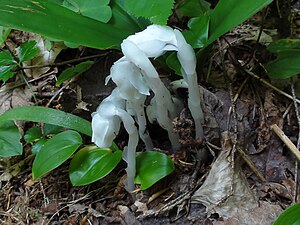Note: This is a project under development. The articles on this wiki are just being initiated and broadly incomplete. You can Help creating new pages.
Monotropa uniflora
Monotropa uniflora, also known as ghost plant (or ghost pipe), Indian pipe or corpse plant, is an herbaceous perennial plant native to temperate regions of Asia, North America and northern South America, but with large gaps between areas. The plant is sometimes completely waxy white, but often has black flecks or pale pink coloration. Rare variants may have a deep red color.
Contents
- 1 Uses
- 2 Parts Used
- 3 Chemical Composition
- 4 Common names
- 5 Properties
- 6 Habit
- 7 Identification
- 8 List of Ayurvedic medicine in which the herb is used
- 9 Where to get the saplings
- 10 Mode of Propagation
- 11 How to plant/cultivate
- 12 Commonly seen growing in areas
- 13 Photo Gallery
- 14 References
- 15 External Links
Uses
tonic, sedative, nervine, antispasmodic.
Parts Used
Chemical Composition
Stamens 10, sometimes 8; anthers short on the thickened apex of the hairy filament, 2-celled, opening by transverse chinks. Stigma 5-crenate, depressed, and beardless. Pod or capsule 5-celled and 5-valved; the seeds numerous, and invested with an arillus-like membrane. [1]
Common names
| Language | Common name |
|---|---|
| Kannada | |
| Hindi | |
| Malayalam | |
| Tamil | |
| Telugu | |
| Marathi | NA |
| Gujarathi | NA |
| Punjabi | NA |
| Kashmiri | NA |
| Sanskrit | |
| English | Indian Pipe, Ghost Flower, Ghost Flower |
Properties
Reference: Dravya - Substance, Rasa - Taste, Guna - Qualities, Veerya - Potency, Vipaka - Post-digesion effect, Karma - Pharmacological activity, Prabhava - Therepeutics.
Dravya
Rasa
Guna
Veerya
Vipaka
Karma
Prabhava
Habit
Identification
Leaf
| Kind | Shape | Feature |
|---|---|---|
| Simple | variable | The stems reach heights of 10-30 cm, clothed with small scale-leaves 5-10 mm long. As its species name monoflora suggests, the stems bear only a single flower, 10-15 mm long with 3-8 petals. It flowers from early summer to early autumn. |
Other features
List of Ayurvedic medicine in which the herb is used
Where to get the saplings
Mode of Propagation
How to plant/cultivate
It is likely to require shady woodland conditions in a humus-rich moist soil, It is a saprophytic plant, quite devoid of chlorophyll and depending totally on its host plant for nutrient. [3]
Commonly seen growing in areas
Photo Gallery
References
External Links
- Ayurvedic Herbs known to be helpful to treat tonic
- Ayurvedic Herbs known to be helpful to treat sedative
- Ayurvedic Herbs known to be helpful to treat nervine
- Ayurvedic Herbs known to be helpful to treat antispasmodic
- Herbs with Roots used in medicine
- Herbs with common name in English
- Habit - Herbs
- Index of Plants which can be propagated by Seeds
- Herbs that are commonly seen in the region of Northern forest
- Herbs
- Ericaceae



